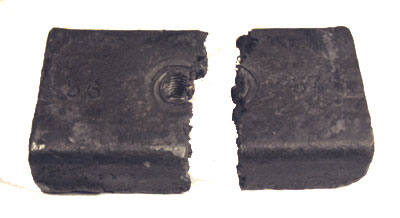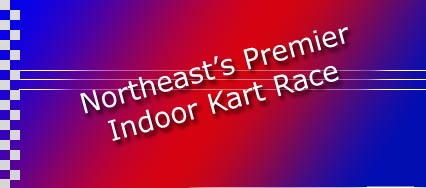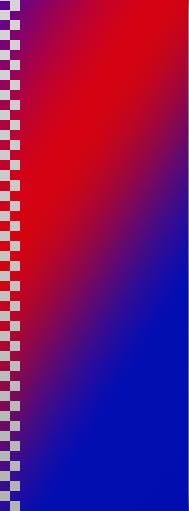Tech Summary for Syracuse Indoor Karting
This is a summary of some of the most commonly asked questions about the tech inspection and rules at Syracuse. Please also download the Event Flyer for tech information. If you still don't have an answer to your question, please contact syrindoor@gmail.com.
Except as noted in the following sections, the general rules are:
- Karts follow WKA rules.
- Clones follow AKRA Rules, with open pipe and open clutch.
- Xtreme Budget Predator karts follow their own separate set of rules (see Action Park East web page).
- Quarter Midgets follow USAC rules.
All classes must also conform to the following rules and exceptions:
WEIGHTS
Weights must be bolted to the chassis or seat. The nerf bars are considered part of the chassis. For weights on the seat, you must use fender washers (large washers) under the bolt head. Do not attach weights to bodywork. Bolts must be safety wired (meaning the bolt must be cross-drilled with a safety wire through it).
Having said that, safety is the overriding issue. If the Race Director feels your weights are not safely attached, you will have to change them to suit him.
Here is a weight which went flying past the head flagger, close enough that he could have reached out and caught it:

This 3-pound weight was probably attached per the rules. However, it still came off, because it broke. The point is: no matter how many rules we make, bad things can and will happen. But we also don't want weights coming off! So your kart will be inspected to make sure that the weights are safely attached. Decisions of the race director are final!
SEAT HEIGHT
Seat height is a non-tech item. This is a typical "indoor" rule, which is not WKA. For indoor racing, being lower in the kart is probably safer (less likely to bicycle). Competitors are encouraged to be creative in finding a seat placement, seat style, and height that makes them go fastest.
TIRE PREP
You may not bring a kart to the grid with wet tires. Tires must be dry. No prep may be applied to the tires during a pit stop (the Pro race has pit stops).
You may heat your tires with an electric heat gun and scrap them. You may not use an open flame!
Some teams like to use wire brushes or abrasive disks to clean their tires. That's fine too. Just be careful about generating sparks! Fire is bad.
COMPETITION YELLOWS
In addition to throwing the yellow flag when there is a safety problem on the track, we also throw the yellow flag for certain competitive situations.
Specifically, we throw the yellow when any of our scoring people (there are four of them) asks for a yellow. Why? With six-second laps and 12 karts on the track, it's dizzying trying to keep track of the race order. If you fall behind, there is no way to catch up. So, if any of the four scoring people falls behind, they grab their radio button and yell "yellow", and out comes a competition yellow. We reset the field, and the race resumes.
Now, as you can imagine, this situation mostly arises when the leaders catch up to the trailing karts, and start to put people down a lap. That's when the racing gets most confusing to score, and it's when we are most likely to throw a yellow. Because of this, some racers mistakenly believe that at Syracuse, we throw competition yellows whenever the leaders start to lap other karts. This is not our policy. It may look that way, but in truth we only throw competition yellows when there is a problem scoring the race.
Ideally, we would score the race electronically, but we are not permitted to cut the floor to install a "loop". We've tried gluing or taping down a loop, but it doesn't work. So, no loop, no electronic scoring.
The single biggest reason we throw competition yellows is poorly marked karts. Many karts don't have numbers on the front and back, where they are most important. A kart with metallic silver numbers on a bright orange body may look nice in publicity photos, but it's nearly impossible to see when it's travelling 45 feet per second.
If racers want fewer competition yellows, it's easy to do. Put white numbers on black panels, or black numbers on white panels, front, back, and on each side. That would do a lot to reduce the headaches and delays caused by these yellows.
ENGINES
Engines must follow WKA rules, except clone classes follow AKRA rules. Motors and carbs will be painted. The top few positions in the Pro race will always be torn down post-race. Allow extra time for this. All classes are potentially subject to tech, but only the Pro class is automatically subjected to a complete tech teardown.
OIL CATCH CAN
Nothing destroys a cola syrup track faster than hot engine oil. You must have a catch can that will prevent oil spilling during an accident or when you are upside down.
MUFFLERS and AIR BOXES
4-cycle: RLV muffler mandatory. Yamaha and Controlled: air box mandatory.
FUEL
Fuel will be tested.
WEIGHT
Karts will be weighed at the end of each heat and race. Scales are available for trial weighing throughout the event.
Page last updated Wednesday, March 6, 2024


